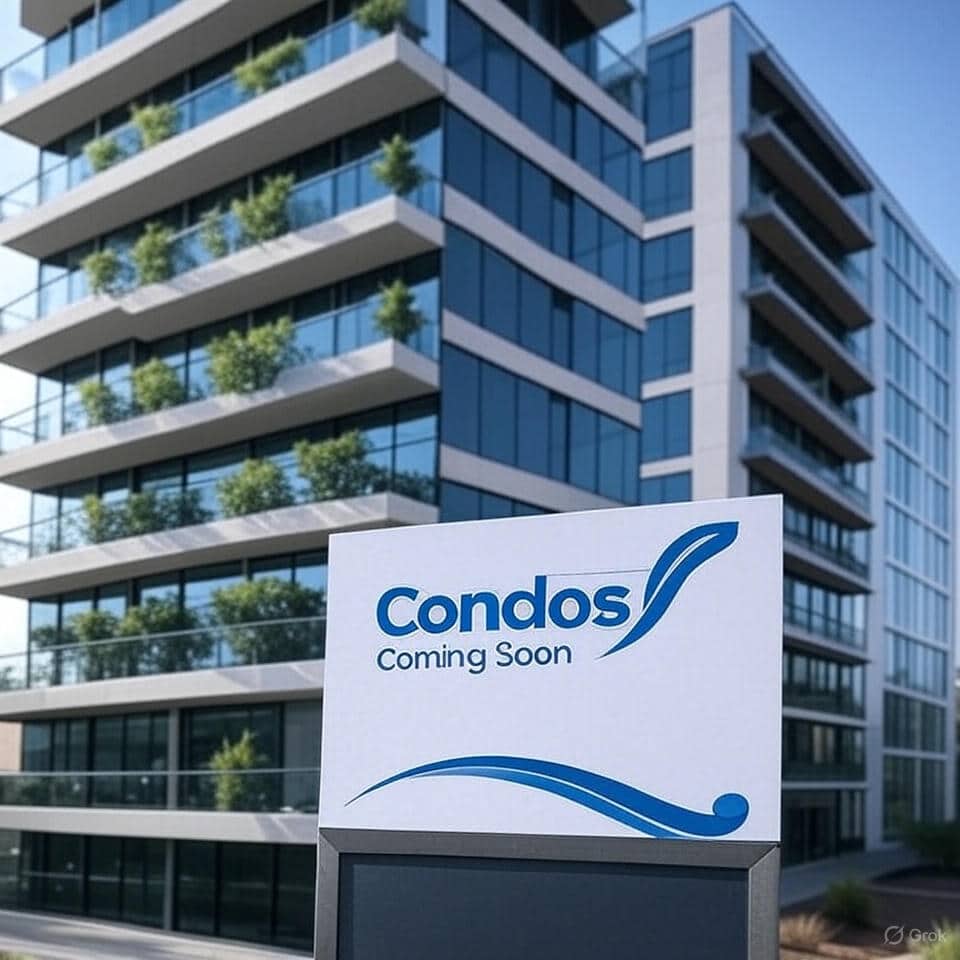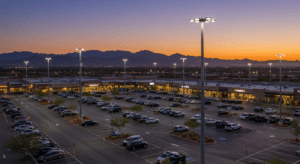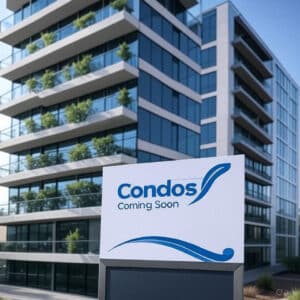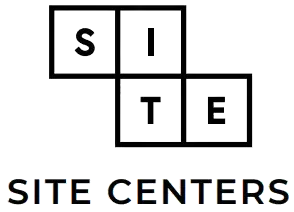As urban landscapes evolve, adaptive reuse has emerged as a transformative strategy to breathe new life into underutilized buildings. In the Phoenix metro market, where rapid growth meets shifting economic demands, adaptive reuse offers a promising solution to address both a national office vacancy rate of 19.4% (as of May 2025) and a pressing need for housing. By converting outdated commercial spaces into residential or mixed-use developments, cities can revitalize neighborhoods, boost economic vitality, and tackle housing shortages. However, as the recent controversy surrounding the Axon development in Scottsdale illustrates, such projects can spark significant community pushback, even when they differ from traditional adaptive reuse. This blog post explores the concept of adaptive reuse, its opportunities in the Phoenix metro area, and the potential downsides, with a focus on lessons learned from the Axon case.
What is Adaptive Reuse?
Adaptive reuse involves repurposing existing buildings for new uses, often transforming vacant or underused commercial properties—such as office buildings, warehouses, or retail spaces—into residential units, mixed-use developments, or other community-serving spaces. Unlike new construction, adaptive reuse leverages existing structures, reducing environmental impact, preserving historic character, and often lowering development costs. In the Phoenix metro area, where office vacancies have climbed alongside a growing population, adaptive reuse aligns with the city’s goals of sustainability and urban revitalization, as outlined in Phoenix’s Adaptive Reuse Program.
The process typically involves identifying distressed or functionally obsolete properties, navigating zoning and regulatory frameworks, and securing financial incentives like tax waivers or grants. For example, cities like San Francisco have implemented programs offering fee eliminations and zoning waivers to streamline office-to-residential conversions. Phoenix has followed suit with its own Adaptive Reuse Program, which aims to transform commercial and multifamily buildings to enhance neighborhood vibrancy and sustainability.
Opportunities in the Phoenix Metro Market
Addressing Office Vacancies
The Phoenix metro market, a hub of Sun Belt growth, faces challenges with office vacancies, mirroring the national average of 19.4%. As remote work persists and companies downsize office footprints, vacant office spaces create opportunities for adaptive reuse. Converting these spaces into residential units can reduce vacancy rates while meeting housing demand, particularly in a region with over 64,000 build-to-rent units under construction. Phoenix’s history of adaptive reuse is notable, with 4.5 million square feet of office space created through conversions over the past century, primarily from industrial and retail properties. Now, the focus is shifting toward office-to-residential conversions to address modern needs.
Meeting Housing Demand
Phoenix’s population growth has intensified the need for housing, especially affordable options. Adaptive reuse offers a faster, more cost-effective alternative to new construction, as it repurposes existing structures rather than building from scratch. For instance, older office buildings with smaller floor plates (ideally under 15,000 square feet) are prime candidates for conversion into apartments or mixed-use developments. By leveraging existing infrastructure, developers can deliver housing units more quickly, helping to alleviate the region’s housing shortage, which mirrors national trends where affordable housing is a major concern for 49% of Americans.
Economic and Environmental Benefits
Adaptive reuse projects contribute to economic vitality by attracting residents, businesses, and investment to urban cores. In Phoenix, developments like the revitalized Downtown Phoenix area, transformed from a business hub into a live/work/play neighborhood, demonstrate this potential. These projects also generate tax revenue and create vibrant, 24/7 communities. Environmentally, adaptive reuse reduces embodied carbon by extending the life of existing materials, aligning with sustainability goals. For example, repurposing a building can lower its carbon footprint by up to 25% compared to new construction.
Leveraging Incentives and Programs
Phoenix’s Adaptive Reuse Program offers streamlined permitting processes and incentives to encourage conversions. Developers can benefit from tax waivers, fee reductions, or historic preservation credits, similar to those in San Francisco’s Commercial to Residential Adaptive Reuse Program. These incentives reduce financial barriers, making projects more feasible. Additionally, Arizona’s broader regulatory environment, including recent updates to zoning codes, supports adaptive reuse by simplifying use changes in commercial zones.
Practical Steps for Developers
For developers eyeing adaptive reuse in Phoenix, the process begins with scouting distressed properties. Older office buildings, particularly those built before the 1980s, are often ideal due to their smaller floor plates and proximity to urban amenities. Next, developers must navigate zoning hurdles, which may require variances or rezoning to allow residential use in commercial zones. Engaging with city officials through programs like Phoenix’s Planning and Development Department can streamline approvals. Finally, securing financing, such as adaptive reuse loans or tax credits, is critical to offsetting costs, as seen in projects like the Travis Building in San Antonio, which utilized a $5 million adaptive reuse loan.
The Axon Development Controversy: A Case Study in Community Backlash
While adaptive reuse holds immense potential, the recent Axon development controversy in Scottsdale highlights the challenges of high-density housing projects, even when they differ from traditional adaptive reuse. In 2025, Axon, a Scottsdale-based company known for manufacturing tasers and body cameras, proposed a new headquarters development that included 1,900 apartments alongside commercial spaces. Unlike adaptive reuse, which repurposes existing structures, this project involved new construction on a 74-acre site. However, the plan to introduce high-density housing sparked significant community opposition.
Over 27,000 Scottsdale residents signed a petition to put the project on the ballot, reflecting concerns about increased traffic, strain on infrastructure, and changes to the city’s character. The controversy escalated, with residents and some city officials arguing that the development was incompatible with Scottsdale’s low-density, suburban identity. Ultimately, Axon withdrew from the project, citing a “toxic environment” related to the City Council’s handling of the issue. This case underscores the potential for community backlash when high-density housing is introduced, even in projects that differ from adaptive reuse.
Potential Downsides of Adaptive Reuse in Phoenix
Community Resistance
The Axon case, while not a direct example of adaptive reuse, illustrates a key challenge: community resistance to high-density housing. In Phoenix and its suburbs, residents often value open spaces and low-density development, particularly in affluent areas like Scottsdale. Converting office buildings into apartments can raise similar concerns about traffic congestion, parking shortages, and neighborhood character. For instance, adaptive reuse projects that increase residential density in commercial zones may face pushback from residents fearing overdevelopment or loss of local identity. Engaging communities early through public forums and transparent planning processes is essential to mitigate opposition.
Zoning and Regulatory Hurdles
Zoning remains a significant barrier to adaptive reuse in Phoenix. Many office buildings are zoned solely for commercial use, requiring variances or rezoning to allow residential development. Obtaining these approvals can be time-consuming and costly, especially if private restrictions, such as covenants or easements, prohibit residential use. For example, older office parks may have agreements that limit changes in use, complicating conversions. Phoenix’s Adaptive Reuse Program aims to address these issues, but developers must still navigate a complex regulatory landscape.
Financial and Structural Challenges
Adaptive reuse projects are not always cost-effective. Retrofitting older buildings to meet residential building codes—such as fire safety, accessibility, and HVAC requirements—can be expensive. Structural adaptations, like reconfiguring office layouts for apartments, may require significant investment, particularly for buildings with large floor plates unsuitable for residential use. Moreover, while incentives like tax waivers help, most conversions in other markets have resulted in luxury properties rather than affordable housing, potentially limiting their impact on Phoenix’s housing crisis.
Market Risks
The success of adaptive reuse depends on market conditions. In Phoenix, where retail vacancies are low (under 5% in 2025), competition for space is high, and developers may face challenges securing viable properties. Additionally, economic uncertainties, such as rising construction costs or fluctuating interest rates, can undermine project feasibility. The Axon controversy also highlights the risk of political and community opposition derailing projects, even those with strong economic potential.
Lessons from Other Markets
Phoenix can draw inspiration from successful adaptive reuse projects elsewhere. In New York, the conversion of 222 Broadway, a 1961 office building, into 798 apartments demonstrates the potential for large-scale transformations. New York’s Office Conversion Accelerator program streamlined zoning and permitting, offering a model for Phoenix to emulate. Similarly, San Francisco’s Commercial to Residential Adaptive Reuse Program, with its tax waivers and fee eliminations, has spurred projects like the Humboldt Residences, converting a 19-story office building into 120 housing units. These examples highlight the importance of city-led incentives and regulatory flexibility in overcoming barriers.
Conclusion
Adaptive reuse presents a transformative opportunity for the Phoenix metro market to address office vacancies, meet housing demand, and revitalize urban areas. By repurposing vacant office buildings, developers can create vibrant, sustainable communities while leveraging incentives like Phoenix’s Adaptive Reuse Program. However, the Axon development controversy serves as a cautionary tale, highlighting the potential for community backlash against high-density housing projects, even those distinct from adaptive reuse. To succeed, developers must navigate zoning hurdles, manage costs, and engage communities proactively. By learning from both local challenges and successful models like New York’s 222 Broadway, Phoenix can harness adaptive reuse to shape a resilient, dynamic future.














